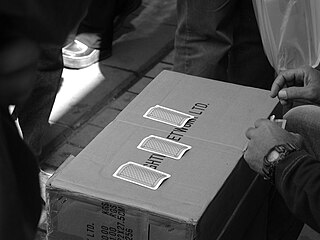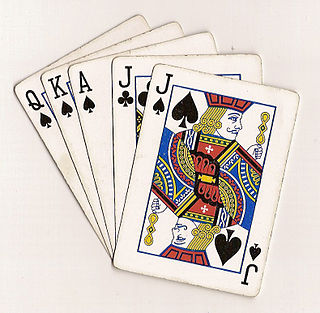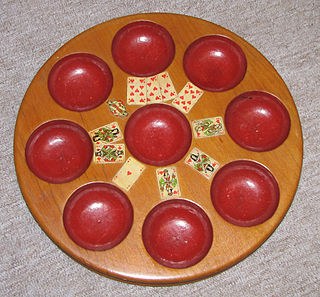
Blackjack is a casino banking game. It is the most widely played casino banking game in the world. It uses decks of 52 cards and descends from a global family of casino banking games known as "twenty-one". This family of card games also includes the European games vingt-et-un and pontoon, and the Russian game Ochko. Blackjack players do not compete against each other. The game is a comparing card game where each player competes against the dealer.

Baccarat or baccara is a card game played at casinos. It is a comparing card game played between two hands, the "player" and the "banker". Each baccarat coup has three possible outcomes: "player", "banker", and "tie".

Basset, also known as barbacole and hocca, is a gambling game using cards, that was considered one of the most polite. It was intended for persons of the highest rank because of the great losses or gains that might be accrued by players.

Faro, Pharaoh, Pharao, or Farobank is a late 17th-century French gambling game using cards. It is descended from Basset, and belongs to the Lansquenet and Monte Bank family of games due to the use of a banker and several players. Winning or losing occurs when cards turned up by the banker match those already exposed.

Primero, is a 16th-century gambling card game of which the earliest reference dates back to 1526. Primero is closely related to the game of primo visto, if not the same. It is also believed to be one of the ancestors to the modern game of poker, to which it is strikingly similar.

Thirty-one or Trente et un is a gambling card game played by two to seven people, where players attempt to assemble a hand which totals 31. Such a goal has formed the whole or part of various games like Commerce, Cribbage, Trentuno, and Wit and Reason since the 15th century. 31 is popular in America and Britain.
Rouge et Noir is a patience card game which is played using two decks of playing cards. It is a unique game where two types of building are done in the same game.

Three-card monte – also known as find the lady and three-card trick – is a confidence game in which the victims, or "marks", are tricked into betting a sum of money, on the assumption that they can find the "money card" among three face-down playing cards. It is very similar to the shell game except that cards are used instead of shells.

Napoleon or Nap is a straightforward trick-taking game in which players receive five cards each and whoever bids the highest number of tricks chooses trumps and tries to win at least that number of tricks. It is often described as a simplified version of Euchre, although David Parlett believes it is more like "an elaboration of Rams". It has many variations throughout Northern Europe, such as Fipsen. The game has been popular in England for many years, and has given the language a slang expression, "to go nap", meaning to take five of anything. It may be less popular now than it was, but it is still played in some parts of southern England and in Strathclyde. Despite its title and allusions, it is not recorded before the last third of the nineteenth century, and may have been first named after Napoleon III.

Monte Bank, Mountebank, Spanish Monte and Mexican Monte, sometimes just Monte, is a Spanish gambling card game and was known in the 19th century as the national card game of Mexico. It ultimately derives from basset, where the banker (dealer) pays on matching cards. The term "monte" has also been used for a variety of other gambling games, especially varieties of three-card poker, and for the swindle three-card monte.

Gilet, also Gile, Gillet, is a 16th-century Italian gambling card game that probably predates the game of Primero. Rabelais, in 1534, gives it pride of place in his list of games played by Gargantua, and Cardano, in 1564, describes it as Geleus, from the word Geleo, meaning "I have it".

The following is a glossary of terms used in card games. Besides the terms listed here, there are thousands of common and uncommon slang terms. Terms in this glossary should not be game-specific, but apply to a wide range of card games played with non-proprietary packs. It should not include terms solely related to casino or banking games. For glossaries that relate primarily to one game or family of similar games, see Game-specific glossaries.
Einwerfen or Zählspiel is a German 8-card point-trick game for four players in two teams of two and using a 32-card German-suited pack. Its closest relative is the popular Portuguese game Sueca. Perhaps the most basic and typical representative of the ace–ten card games, this game was first described as early as 1811, but may be considerably older.

Poch, Pochen or Pochspiel is a very old card game that is considered one of the forerunners of poker, a game that developed in America in the 19th century. An etymological relationship between the game names is also assumed. Games related to Poch are the French Glic and Nain Jaune and the English Pope Joan. Other forerunners of poker and possible relatives of the game are the English game, Brag, from the 16th century and the French Brelan and Belle, Flux et Trente-et-Un. Poch is recorded as early as 1441 in Strasbourg. In north Germany it was called by the Low German name of Puchen or Puchspill, and the board was a Puchbrett.

Belle, Flux et Trente-et-Un, is an historical, gambling card game that was widespread in France and Germany during the 17th and 18th centuries. As a relative of Brag and Poch, from which the game of Poker developed, it is of cultural-historical interest.
Rouge et Noir - French for "red and black" - may refer to:

Twenty-one, formerly known as vingt-un in Britain, France and America, is the name given to a family of popular card games of the gambling family, the progenitor of which is recorded in Spain in the early 17th century. The family includes the casino games of blackjack and pontoon as well as their domestic equivalents. Twenty-one rose to prominence in France in the 18th century and spread from there to Germany and Britain from whence it crossed to America. Known initially as vingt-un in all those countries, it developed into pontoon in Britain after the First World War and blackjack in Canada and the United States in the late 19th century, where the legalisation of gambling increased its popularity.

Mouche, also known as Lanterlu, is an old, French, trick-taking card game for two to six players which has elements, such as bluffing, reminiscent of the much later game of poker. It is a member of the Rams family of games and, although it is a gambling game, often played for small stakes, it is also suitable as a party game or as a family game with children from the age of 12 upwards. It is named after the mouche, a term that variously refers to its winning hand, the basic stake and the penalty for failing to take any tricks. Although also called Bête, it should not be confused with the older game of that name from which it came and which, in turn, was a derivative of Triomphe.

Norseman's knock or Norrlandsknack is a classic Swedish card game for 3 to 5 players, known since the mid-1800s. It is traditionally played for money. The game is about winning as many tricks as possible and above all not being completely left without a trick.

Quarante de Roi or Quarante de Rois is an historical French, point-trick, card game for four players in partnerships of two. The name comes from its highest scoring combination of four Kings which is worth 40 points.
















